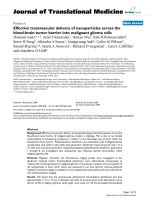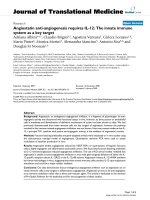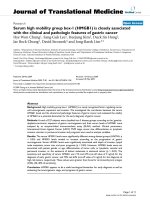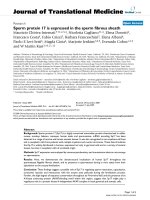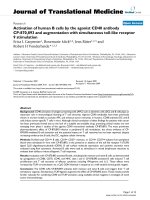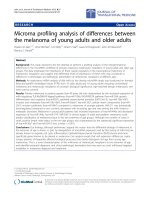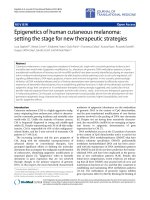báo cáo hóa học:" Hypothermic cardiac arrest far away from the center providing rewarming with extracorporeal circulation" potx
Bạn đang xem bản rút gọn của tài liệu. Xem và tải ngay bản đầy đủ của tài liệu tại đây (96.19 KB, 9 trang )
This Provisional PDF corresponds to the article as it appeared upon acceptance. Fully formatted
PDF and full text (HTML) versions will be made available soon.
Hypothermic cardiac arrest far away from the center providing rewarming with
extracorporeal circulation
International Journal of Emergency Medicine 2012, 5:7 doi:10.1186/1865-1380-5-7
Eckhard Mark ()
Olaf Jacobsen ()
Astrid Kjerstad ()
Torvind Naesheim ()
Rolf Busund ()
Ramez Bahar ()
Jon K Jensen ()
Per-Kristian Skorpen ()
Lars J Bjertnaes ()
ISSN 1865-1380
Article type Case report
Submission date 12 September 2011
Acceptance date 1 February 2012
Publication date 1 February 2012
Article URL />This peer-reviewed article was published immediately upon acceptance. It can be downloaded,
printed and distributed freely for any purposes (see copyright notice below).
Articles in International Journal of Emergency Medicine are listed in PubMed and archived at
PubMed Central.
For information about publishing your research in International Journal of Emergency Medicine go to
/>For information about other SpringerOpen publications go to
International Journal of
Emergency Medicine
© 2012 Mark et al. ; licensee Springer.
This is an open access article distributed under the terms of the Creative Commons Attribution License ( />which permits unrestricted use, distribution, and reproduction in any medium, provided the original work is properly cited.
1
Case report
Hypothermic cardiac arrest far away from the center providing rewarming
with extracorporeal circulation
Eckhard Mark
1
, Olaf Jacobsen
2
, Astrid Kjerstad
2
, Torvind Naesheim
2
, Rolf Busund
3
, Ramez
Bahar
3
, Jon Kjetil Jensen
4
, Per-Kristian Skorpen
5
, and Lars J Bjertnaes*
1,2,6
*Corresponding author:
1
Department of Emergency Medical Services, University Hospital of North Norway, Tromsø,
Norway
2
Department of Anesthesiology, University Hospital of North Norway, Tromsø, Norway
3
Department of Thoracic and Cardiovascular Surgery, University Hospital of North Norway,
Tromsø, Norway
4
Department of Medical Engineering, University Hospital of North Norway, Tromsø, Norway
5
Department of Medicine, Stokmarknes Hospital, Stokmarknes, Norway
6
Anesthesia and Critical Care Research group, Institute of Clinical Medicine, Faculty of
Health Sciences, University of Tromsø, Tromsø, Norway
Email addresses:
EM:
OJ: : :
:
RB: : 'P-KS:
:
2
Abstract
A 41-year-old man suffered hypothermic cardiac arrest after water immersion and was trans-
ported to our university hospital by ambulance helicopter for rewarming on cardiopulmonary
bypass. He resumed spontaneous cardiac activity 6 h 52 min after cardiac arrest and recovered
completely.
Background
In the Northern hemisphere, most victims of accidental hypothermic cardiac arrest have a
history of drowning or entombment by avalanches. Consequently, asphyxia and cardiac arrest
develop before the body temperature has fallen to a sufficiently low level for oxygen demand
to meet the supply. However, some patients have the advantage that they can breathe while
being cooled until the heart stops [1-5].
Case report
An alcohol-intoxicated man, 41 years of age, fell into a river on the coast of North Norway
after leaving a party between 3 and 4 o’clock a.m. on 30 December. Approximately 1 h later,
passers by spotted him shouting for help and pulled him out of the water. One of them un-
dressed and attempted to warm him by skin-to-skin contact at the prevailing air temperature
of -2
o
C. The patient lost consciousness and stopped breathing as the paramedics lifted him
into the ambulance at 04.45 a.m. One of them started cardiopulmonary resuscitation (CPR)
and continued it during the drive to the local hospital. Upon arrival at 05.01 a.m., his electro-
cardiogram (ECG) was isoelectric, rectal temperature was 27.5
o
C, and arterial blood gases
displayed pH 7.00, PaCO
2
10.60 kPa, PaO
2
3.60 kPa, HCO
3
-
18.5 mmol/l, and BE -11.3
mmol/l. He had no visible injuries except for a wound in the occipital region. He was endotra-
cheally intubated and received 90 mmol of trimetamol (Tribonat
®
, Fresenius Kabi AS, Oslo,
Norway) intravenously (IV). Following two IV injections of 1 mg epinephrine (Adrenalin
®
,
3
Nycomed Pharma AS, Asker, Norway), his ECG shifted to ventricular fibrillation (VF), but
attempts at defibrillation failed. At 6.00 o’clock, the physician in charge contacted the ambu-
lance dispatch center of the University Hospital of North Norway (UNN) in Tromsø (latitude:
69
o
, 40’ North). The anesthesiologist on duty for the helicopter and the thoracic surgical team
decided to fly the 260 km (140 NM) to the local hospital and bring the patient to UNN for
rewarming by means of extracorporeal circulation. The helicopter that was prepared for in-
strument flights took off at 06.45 a.m. When starting the return flight from the local hospital
at 08.00 a.m., the stretcher was turned across the cabin. This facilitated optimum access for
manual ventilation (10 inflations per min, FiO
2
1.0) and external cardiac compression (100
compressions per min) carried out alternately by the anesthesiologist and a nurse anesthetist
with no hands off time [6].
After landing at UNN at 08.45 a.m., the patient was transferred to the emergency room
where his arterial blood gases showed: pH 6.88, PaO
2
26.20 kPa, PaCO
2
7.62 kPa, and base
excess -21 mmol/l. Serum creatine phosphokinase (CPK) and myoglobin were 14,000 µg/l
and 3,017 U/l, respectively, K
+
5.9 mmol/l, Ca
2+
1.7 mmol/l, and rectal temperature 25
o
C.
The ECG displayed a coarse VF. The occipital wound was sutured, and at 09.18 a.m., he was
connected to a cardiopulmonary bypass (CPB) using a fully heparin-coated system with ac-
cess via the right femoral vein and artery. After 30 min on CPB, 5 h 3 min after cardiac arrest,
his esophageal temperature had increased to 33
o
C, and the VF was electro-converted into a
nodal rhythm, which resulted in asynchronous ventricular contractions, as assessed by transe-
sophageal echocardiography. After 2 h 21 min on CPB, his rectal temperature had risen fur-
ther to 36.5
o
C paralleled by gradually improving cardiac function. He was weaned off CPB at
11.37 a.m., 6 h 52 min after cardiac arrest, maintaining a mean systemic arterial pressure of
55 mmHg supported by infusions of norepinephrine (Noradrenalin
®
, NAF, Oslo, Norway)
130 ng/kg/min, Pitressin (Glypressin
®
, Ferring legemidler, Oslo, Norway) 120 ng/kg/min, and
4
milrinon (Corotrop
®
, Sanofi-Aventis Norge, Oslo, Norway) 120 ng/kg/min. At 12.30 a.m., he
was transferred to the ICU. Then, his serum myoglobin was 17,000 µg/l, ASAT 1,242 U/l,
ALAT 214 U/l, creatinine 195 µmol/l, CK-MB 61 µg/l, thrombocyte count 50 × 10
9
/l, fi-
brinogen 1.0 g/l, D-dimer 10.7 µg/l FEU, and antithrombin III 27 %, and the ethanol gel test
was positive. Concomitantly, arterial oxygen saturation (SaO
2
) reached a nadir of 73%. He
was subjected to airway recruitment, and the SaO
2
level rose to 90%.
Postoperatively, his condition was complicated with pneumonia requiring antibiotics and
continuation of pressure-controlled mechanical ventilation (Servo I, MAQUET GmbH & Co.,
Rastatt, Germany). Moreover, renal failure as assessed by hourly diuresis of below 20 ml/h;
serum urea and creatinine levels of 11.3 mmol/l and 195µmol/l, respectively, indicated the
need for veno-venous hemofiltration (Prismaflex system, Gambro, Lund, Sweden). The co-
agulation dysfunction normalized after transfusion of freshly frozen plasma and thrombocyte
concentrates, and the patient’s liver function regressed during the first week. He was weaned
off mechanical ventilation and extubated on 3 January, and was transferred to the local hospi-
tal 12 days later. In a letter 3 years after the accident he wrote that he has quit smoking and
abusing alcohol, and works as a logistic consultant. He has no neurological sequelae and en-
joys life with his family. He wanted us to emphasize in the case report that the accident be-
came an incentive for him to change to a healthier lifestyle.
Discussion
We are not aware of previous reports of successful resuscitation after hypothermic cardiac
arrest of a comparably long duration. A PubMed search revealed the case of an alcohol-
intoxicated man who was found outdoors with cardiac arrest and a rectal temperature of 23.2
o
C. Subjected to surface rewarming combined with intraperitoneal lavage and intravenously
infused warm fluids at the local hospital, he resumed spontaneous circulation with sinus
rhythm at a rectal temperature of 28
o
C 6 h after CPR was started. However, neurological ex-
5
amination before discharge revealed “slow cerebration” and peripheral neurological dysfunc-
tion in both arms [3].
Walpoth and co-workers surveyed the outcomes of victims of accidental hypothermic
cardiac arrest varying between 30 min and 4 h who were successfully rewarmed with extra-
corporeal circulation [4]. Recently, colleagues at our hospital reported the case of a female
off-piste skier who fell and was trapped head down between rocks and overlying ice, and
sprinkled with glacial water in her face until cardiac arrest. With a body temperature reaching
a nadir of 13.7
o
C and cardiac arrest for almost 3 h, she was successfully resuscitated on CPB
followed by a period of extracorporeal membrane oxygenation because of severe respiratory
failure. She had no sequelae 2 years later [5].
Regarding our patient, a well-equipped ambulance dispatch center and its staff of special-
ized nurses and flight coordinators, supervised by the anesthesiologist on duty for the helicop-
ter, played an important role by coordinating the total pre- and intra-hospital resources. Be-
cause of other similar actions during the last few years, the center, which is an integral part of
our Department of Emergency Medical Services, has obtained experience in coordinating the
transfer of patients with cardiac arrest with rotor or fixed-wing aircraft over long distances
[5]. Our university hospital is the only center for cardiovascular surgery in the area providing
rewarming with extracorporeal circulation. The next center is located in Trondheim, approxi-
mately 600 km to the south. Although the dispatch center could have chosen to use a corre-
spondingly staffed and equipped ambulance plane, flying at double speed, the helicopter was
preferred because it could provide “door-to-door” transfer.
Arriving at the local hospital under ongoing CPR, the rectal temperature of the patient al-
ready had fallen by 10
o
C, which corresponds to a 60−70% decrease in cerebral metabolic
rate, based on a 6–7% reduction per degree fall in body temperature [7]. Presumably, his al-
cohol intoxication helped him avoid most of the shivering and the resulting increase in oxy-
6
gen consumption that normally occurs during exposure to cold water. In anesthetized dogs
cooled from 37 to 25
o
C core temperature, investigators noticed that cardiac output fell spon-
taneously by 65% [8]. Although performed by experienced specialists according to the guide-
lines [6], we have no evidence of the efficacy of the cardiac compressions. However, by ex-
trapolating from the results of the latter investigators, we assume that a cardiac output of 30–
40% of normal should be sufficient to balance the oxygen demand at a body temperature be-
low 27
o
C. The latter estimate also corresponds to a decrease in cerebral blood flow to 40% of
normal, which was observed in pigs undergoing external manual cardiac compression during
normothermic circulatory arrest [9]. Although uninterrupted cardiac compression from the
scene of the accident might have satisfied most of the patient’s oxygen demand until he was
connected to CPB, acidosis made likely that he had suffered some degree of hypoxia. More-
over, the fact that relatively high doses of norepinephrine, Pitressin, and milrinon were neces-
sary to wean him off CPB, even with a low systemic arterial pressure, suggests that he was
subjected to “rewarming shock.” It is believed that this type of circulatory failure, which has
been observed in various species after hypothermia and rewarming, and often with a fatal out-
come, is associated with intracellular Ca
2+
overload [10]. However, the exact mechanism of
this dysfunction of intracellular ion transport remains unsettled.
High serum levels of myoglobin and CPK indicate that the patient had a rhabdomyolysis that,
most likely, triggered his renal and hepatic failures in concert with disseminated intravascular
coagulation [11]. Thus, including a transient central nervous impairment and respiratory fail-
ure, our patient suffered at least five organ failures. However, in addition to a complete physi-
cal and mental recovery, he has also adopted a healthier lifestyle.
Conclusion
7
To the best of our knowledge, 6 h 52 min is the longest time reported until the return of spon-
taneous circulation and recovery without physical or mental sequelae after hypothermic car-
diac arrest. We believe that well-integrated pre-hospital as well as local and university hospi-
tal medical services were important prerequisites for the successful outcome of this patient.
Abbreviations
CPB: cardiopulmonary bypass; CPR: cardiopulmonary resuscitation; ECG: electrocardio-
gram; IV: intravenously; UNN: University Hospital of North Norway; VF: ventricular fibril-
lation
Consent
Written informed consent was obtained from the patient for publication of this case report. A
copy of the written consent is available for review by the Editor-in-Chief of this journal.
Competing interests
The authors declare that they have no competing interests
Author’s contributions
EM was the anesthesiologist on board the helicopter, conceived the idea for and drafted the
case report. OJ was the nurse anaesthetist on board the helicopter, AK and TN were cardiac
anaesthesiologists on duty, RB and RB were thoracic surgeons, JKJ was the perfusionist, and
P-KS was in charge of treatment at the local hospital. LB wrote and formatted the manuscript.
All the authors have read and approved the final manuscript.
Acknowledgements
We thank the emergency medical technicians Tone Rygh and Anders Samuelsen for initiating
the treatment of the patient from the scene of accident; the dispatch center nurse, Mrs Lotte
Niel, for coordinating the transfer of the patient to the University hospital; and helicopter pilot
Tommy Kraknes and rescuer Stig Hansen.
References
1. Bierens JJ, van der Velde EA, van Berkel M, van Zanten JJ: Submersion in The Nether-
lands: prognostic indicators and results of resuscitation. Ann Emerg Med 1990, 19:1390-
5.
8
2. Boyd J, Brugger H, Shuster M: Prognostic factors in avalanche resuscitation: a system-
atic review. Resuscitation 2010, 81:645-52. Review.
3. Lexow K: Severe accidental hypothermia: survival after 6 hours 30 minutes of cardio-
pulmonary resuscitation. Arctic Med Res 1991, 50(Suppl 6):112-4.
4. Walpoth BH, Walpoth-Aslan BN, Mattle HP, Radanov BP, Schroth G, Schaeffler L,
Fischer AP, von Segesser L, Althaus U: Outcome of survivors of accidental deep hypo-
thermia and circulatory arrest treated with extracorporeal blood warming. N Engl J
Med 1997, 337:1500-5.
5. Gilbert M, Busund R, Skagseth A, Nilsen PA, Solbø JP: Resuscitation from accidental
hypothermia of 13.7 degrees C with circulatory arrest. Lancet 2000, 355:375-6.
6.
7. Michenfelder JD. Anesthesia and the Brain: Clinical, Functional, Metabolic, and Vascular
Correlates. New York: Churchill Livingstone; 1988.
8. Tveita T, Mortensen E, Hevrøy O, Refsum H, Ytrehus K: Experimental hypothermia:
effects of core cooling and rewarming on hemodynamics, coronary blood flow, and myo-
cardial metabolism in dogs. Anesth Analg 1994, 79:212-8.
9. Rubertsson S, Karlsten R: Increased cortical cerebral blood flow with LUCAS; a new
device for mechanical chest compressions compared to standard external compressions
during experimental cardiopulmonary resuscitation. Resuscitation 2005, 65:357-63
10. Kondratiev TV, Wold RM, Aasum E, Tveita T: Myocardial mechanical dysfunction
and calcium overload following rewarming from experimental hypothermia in vivo.
Cryobiology 2008, 56:15-21.
11. Huerta-Alardín AL, Varon J, Marik PE: "Bench-to-bedside review: rhabdomyolysis –
an overview for clinicians". Critical Care 2005, 9:158–69. doi:10.1186/cc2978

